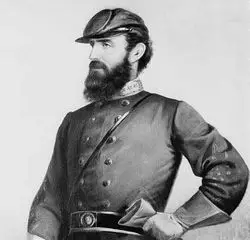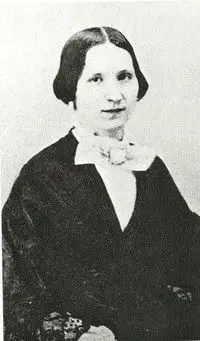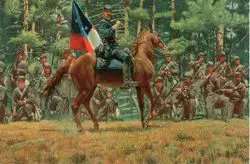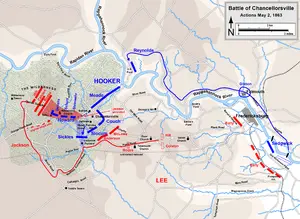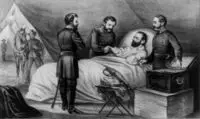Difference between revisions of "How did "Stonewall" Jackson die"
(Created page with "__NOTOC__ thumbnail|250px|left|Thomas J. "Stonewall" Jackson Prior to the 1st Battle of Bull Run, “Stonewall” was simply Thomas J. Jackson. His cont...") |
(No difference)
|
Revision as of 17:08, 16 April 2018
Prior to the 1st Battle of Bull Run, “Stonewall” was simply Thomas J. Jackson. His contributions to the Confederate Army during the American Civil War cannot be over stated. It has often been posited by historians that had Jackson not been mortally wounded during the Battle of Chancellorsville, the outcome of the war may have been different. Like General Robert E. Lee, Jackson was a brilliant tactician and afforded the enemy no quarter.
From the time Jackson was called into service for the Confederate States of America (C.S.A.) until his death in the spring of 1863, Jackson participated in every major battle in the Eastern Theater, suffering only one defeat at the Battle of Kernstown. Lee depended on him enormously and dispatched Jackson’s troops on the most difficult and dangerous missions. Jackson never disappointed as he believed nothing to be impossible and instilled this same philosophy in his soldiers. It was Jackson’s detailed planning and determination that ultimately resulted in his death.
Jackson Before the Civil War
Thomas Jonathan Jackson was born on January 21, 1824 in Clarksburg, a region of Virginia which is now part of West Virginia. He had a turbulent childhood as his father died when Thomas was just three, prompting his mother to send him to live with an uncle. Unsatisfied and restless, Jackson often fled from his new home in an attempt to find happiness. When his relatives managed to force him into a school room, he struggled academically. He had to work extremely hard at his studies in order to keep pace with his classmates.[1]
West Point held the same intellectual challenges for Jackson as had his previous schooling; however, he was not one to fail and pushed himself to far greater lengths than those necessary for his peers. A former classmate remembered that “‘all light were put out at ‘taps,’ and just before the signal he would pile up his grate with anthracite coal, and, lying prone before it on the floor, would work away at his lessons by the glare of the fire.’” His class mate remembered his group of friends saying that “‘If we had to stay here another year, “old Jack” would be at the head of the class.’”[2] This speaks to Jackson’s dedication, not only to learning, but to excelling in whatever task he undertook. His diligence was rewarded when he graduated as 2nd Lieutenant of artillery on June 30, 1846.
At once after graduating, he was deployed into action as the Mexican-American War was raging. Due to his gallantry in battle, he was promoted several times and on March 27, 1851 was awarded a coveted post as an instructor at the Virginia Military Academy (VMI) in Lexington.[3] Jackson's life continued happily as he married Elinor Junkin in August 1853. Tragedy struck, however, just one year hence as his beloved “Ellie” died while giving birth to their still-born child. After years of grief, Jackson married his second wife, Mary Anna, in 1857. Jackson continued to teach at VMI while tensions mounted in throughout the South as the election of 1860 drew nearer.
How Thomas Became "Stonewall"
After Virginia officially seceded from the United States, Colonel Jackson was ordered to Harpers Ferry to organize the rapidly growing number of volunteers into a coherent fighting unit. Proving his capabilities as a leader, Jackson was promoted to Brigadier General and given command of the 1st Virginia Brigade. After the heroics of the Brigade, and those of its general, after the 1st Battle of Bull Run, the 1st Virginia forever became the Stonewall Brigade. Jackson was given the moniker by Confederate General Bernard Bee in 1861 at Manassas.
On July 21, Jackson rode along his men and ordered them to hold fire until the enemy was within 30 paces. The New York Zouaves, notable for their conspicuous red uniforms and tasseled hats, began their attack on Henry House Hill. Artillery was raining down and the entire Confederate left flank was under heavy fire. While troops from Mississippi, Alabama, Georgia, Louisiana, and South Carolina were falling back as ordered, Jackson’s men held their ground. According to Private John O. Casler:
General Bernard E. Bee, riding up to General Jackson, who sat on his horse calm and unmoved, though severely wounded in the hand, exclaimed in a voice of anguish: “General, they are beating us back.” Turning to General Bee, he said calmly: “Sir, we’ll give them the bayonet.”Hastening back to his men, General Bee cried enthusiastically, as he pointed to Jackson: “Look yonder! There is Jackson and his brigade standing like a stone wall. Let us determine to die here and we will conquer. Rally behind them!"[4]
Another account differed as it was said that Bee was in fact irritated by what appeared to be inactivity from Jackson and angrily gestured, “Look at Jackson standing there like a damned stone wall!”[5] What is apparent is that it was in fact Bee who labeled Jackson as Stonewall yet the context under which he spoke is enigmatic and was never able to be discerned as Bee was killed during the battle.
The March to Chancellorsville
General Jackson’s ideology of military strategy was to “always mystify, mislead, and surprise the enemy.”[6]He did indeed surprise the Federal troops who were camped on the outskirts of Chancellorsville in May 1863. The general was waiting near Chancellorsville for the remaining infantry and artillery regiments under his command to complete the 12 mile flanking maneuver they began earlier on the morning of May 2, 1863. Union General Joseph Hooker cleverly moved the bulk of his troops west from Fredericksburg, Virginia into the Chancellorsville area and set-up a defensive stance. This move forced Robert E. Lee to also leave troops stationed at Fredericksburg in order to prevent the Yankee soldiers from making a move south toward Richmond.
After doing excellent reconnaissance work with his cavalry, General J.E.B. Stuart reported back to Lee and Jackson that Hooker was in a defensive position and it was feasible to flank his men on the right. Lee knew Jackson was the man for the job and ordered him to take his 30,000 troops on a forced march, the route of which was to pass in front of Hooker’s line through the woods and thick brush. After receiving information from a local resident, Jackson was given a relatively safe route by which to traverse the enemy’s front and he ordered the movement to begin early on the morning of May 2.
The generals led their men on a 12 mile quick, forced march throughout this warm spring day. The men in file were unaware of their destination. Private John Casler remembered, “We could not imagine where we were going. We continued marching through the fields and woods until about three o’clock in the afternoon. The day was hot, and we marched fast ̶ ̶ the men throwing away their overcoats and blankets.” He continued, “The other two divisions were in front of ours and we began to think Jackson was on one of his flank movements, when one of his couriers came back and told our General to hurry up his command, as General Jackson was waiting for it to form in line."[7] The Stonewall Brigade pushed on and reached the position of their first commander by late afternoon before the battle of the wilderness surrounding Chancellorsville commenced.
The men of 11th Corps of the Union Army, commanded by Oliver O. Howard, were resting and beginning to cook their evening meals. They were situated on the right flank and were wholly unaware that Jackson’s men were poised to attack. Initially, deer, rabbits, and other forest denizens scurried from the woods past the men of the 11th Corps. What followed was a massive attack that consisted of “a front two miles wide and three divisions deep.”[8]The Union flank crumbled for two miles and never fully recovered. Hooker constructed an ersatz battle line from troops that had never before fought together and soon found his position untenable. Jackson understood the severity of the Union’s position and thought it strategically prudent to sever the two separated Union forces by inserting his troops between the Union positions in Fredericksburg and Chancellorsville. A masterful tactician and meticulous planner, Jackson deemed it wise to reconnoiter in front of his lines to determine the most expeditious way to encircle the enemy.
Death of Jackson
Jackson and his small party proceeded approximately fifty yards ahead of the Confederate line on the night of May 3 in order to survey the position of the Hooker’s Union soldiers. At close to nine o’clock p.m., while returning from their reconnaissance, Jackson and his party of three frightened novice soldiers who were on picket duty. The frightened pickets fired on the returning party, unaware they were not the enemy. Jackson suffered three wounds, the most severe being a bullet wound to his left shoulder that severed an artery.
The pickets were made aware of their mistake and ceased firing. The sound of their shots; however, stirred the Union army on the other side of the woods and enemy firing soon commenced. The wounded Jackson, and the others in his party, were still in front of the Confederate battle line. Through the hail of bullets now coming from both sides, Jackson was taken to the rear and eventually received medical care.
In the formal report he filed on May 6, 1863 regarding the Wilderness and the Battle of Chancellorsville, J.E.B. Stuart, who was briefly given command of Jackson's troops, recounted the events that he witnessed after Jackson was wounded: “Captain [R.H.T] Adams, of General A.P. Hill’s staff, reached me post-haste, and informed me of the sad calamities.” Stuart then returned to the site where Jackson was wounded. He continued his report stating that, “General Jackson had gone to the rear, but General A.P. Hill was still on the ground and formally turned over the command to me.”[9]
Four days after Stuart’s report was filed, General Robert E. Lee, while in Fredericksburg, got a message to C.S.A. Secretary of War, James A. Seddon, which stated; “It becomes my melancholy duty to announce to you the death of General Jackson.”[10]
Jackson’s arm was injury to such a degree that amputation was mandated. The left arm was removed at the shoulder and Jackson remained bedridden. Due to this lack of mobility and his weakened state, bacterial pneumonia settled in his lungs. As antibiotics were not yet developed, Jackson, in addition to less than antiseptic conditions coupled with exhaustion, Jackson was unable to ward off the infection with only his own damaged immune system. While confined to his bed, Jackson requested constant updates on the battle that continued to rage, and specifically asked for information about his old brigade. Stonewall Jackson died on May 10, 1863.[11]
Conclusion
Aside from the terrible loss of Jackson, General Paxton was also killed at Chancellorsville, and the Confederates amassed an additional 13,000 casualties.[12]The Union, under the questionable leadership of General Joseph Hooker, was forced to retreat north, making Chancellorsville a strategic victory for the Confederacy. The loss of Jackson; however, offset the victory and was a devastating blow to the Army of Northern Virginia and Robert E. Lee personally. With Jackson on one side and Longstreet on the other, Lee felt invincible and maneuvered his army in some of the most magnificent displays in military history. Had Jackson been at his side three months hence in Gettysburg, the fate of the C.S.A. may have been quite different.
As a means by which to harness their sorrow and honor their revered leader, the members of the 1st Brigade, Virginia Volunteers, requested a formal declaration by the C.S.A. legislature to name the brigade after its founding commander. On May 30, 1863, congress acquiesced and Special Orders, No. 129 was issued by command of the Secretary of War, stating that “the brigade referred to be hereafter designated as the ‘Stonewall Brigade.’”[13]
Related DailyHistory.org Articles
- 19th Century Overview of United States History Top Ten Booklist
- Was the Destruction Perpetrated by Lincoln, Grant, and Sherman Necessary to End the Civil War?
- The Best Historians and Books According to James McPherson
- 19th Century American Intellectual History Top Ten Booklist
- Did the Battle of Fredericksburg Change the Identities of Irish Soldiers?
- Why Was the Battle of Antietam a Pivotal event in the American Civil War?
References
- ↑ Mary Anna Jackson, Memoirs of “Stonewall” Jackson (Louisville: Prentice Press, 1895), 11-25. Mrs. Jackson writes an excellent account of her husband’s life. Although she is biased at times, the memoir contains countless letters from Jackson and first-hand accounts from herself and and other witnesses of historical events. This is recommended reading for anyone interested in the personal aspects of Jackson’s life and offers an insight into his psychological make-up.
- ↑ Jackson, 33.
- ↑ Jackson, 53.
- ↑ John O. Casler, Four Years in the Stonewall Brigade, 2nd ed., 1906 (Endeavour Press, 2016), location 137, Kindle. This is a riveting and honest account of a Confederate Private. Many low-ranked Southern soldiers was unable to read due to the unavailability of education, thereby making the number of memoirs and journals from such men limited. Northern soldiers, in general, had a higher level of education and produced a greater number of accurate and well-written works.
- ↑ Douglas Southall Freeman, Lee’s Lieutenants: A Study in Command, 3 vols. (New York: 1943-44), 1:733-34.
- ↑ John B. Imboden, “Stonewall Jackson in the Shenandoah,” in Battles and Leaders of the Civil War, vol. 2, edited by Clarence C. Buel and Robert U. Johnson (New York: 1888), 297.
- ↑ Casler, location 1897
- ↑ James McPherson, Battle Cry of Freedom: The Civil War Era (New York: Oxford University Press, 1988),642
- ↑ United States War Department, War of the Rebellion: A Compilation of the Official Records of the Union and Confederate Armies, 128 vols. (Washington, D.C.: Government Printing Office, 1888), vol. 25, part I, hereinafter cited as OR.
- ↑ OR, vol. 25, pt. II, p. 791.
- ↑ McPherson, 645.
- ↑ McPherson, 645
- ↑ OR, vol. 25, pt. I, p. 840.
Admin and EricLambrecht
